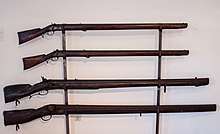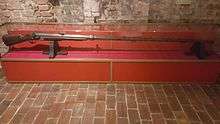Wall gun
The wall gun or wall piece was a type of smoothbore firearm used in the 16th through 18th centuries by defending forces to break the advance of enemy troops. Essentially, it was a scaled-up version of the army's standard infantry musket, operating under the same principles, but with a bore of up to one-inch (25.4 mm) calibre. These weapons filled a gap in firepower between the musket and the lightest artillery pieces, such as the swivel gun. This sort of weapon may also be found described as an amusette, rampart gun,"kodithuwakku",or Hackbut, a name originally given to early medieval hand cannon.[1]

Use
Wall pieces were so named because they were designed to be used along the walls of fortifications.[2] They were equipped with a yoke at the point of balance, which tapered into a pivot, which could be inserted into several sockets along the walls, which would absorb the recoil of the piece and also provide a stable gun platform. (In this respect they were much like a scaled-down version of the swivel gun.) Many were fitted with a barrel hook to absorb shock. Some of these weapons had multiple barrels which enabled volleys to be fired much faster than a normal single-shot wall gun. Wall pieces could also be mounted on very light carriages for service in the field, usually in support of the larger guns. They were also used on small naval vessels.[3]
A wall gun's barrel could be over 4.5 feet (140 cm) in length with a bore of at least 1 inch (2.5 cm). This made them more accurate than the standard flintlock or matchlock musket. George Washington acquired several wall guns during the American War of Independence; tests showed that they were capable of hitting a sheet of common writing paper at 600 yards (550 m) - but since this is comparable performance to a modern full-bore target rifle these results may be queried. Wall guns were part of the standard equipment of some artillery pieces at that time.[4]
During the Napoleonic Wars many of these guns were cut down and turned into blunderbusses. They fired lead shot and were used by naval boarding parties, and by coachmen as protection from highwaymen. A surviving example is preserved in New Zealand.[5]
A breech-loading wall gun was issued to the French army in 1819 for the defense of towns. Improved caplock versions were introduced in 1831 and 1842,[6] as were muzzleloading versions. Bolt action wall guns firing metallic cartridges were used in India and China in the late 19th century.[7]
Naval uses
When HMS Espoir captured the Genoese privateer Liguria on 7 August 1798, Espoir's captain, Commander Loftus Otway Bland, catalogued Liguria's armaments as: 12 long 18-pounders, four long 12-pounders, 10 long 6-pounders, 12 long wall-pieces, and four swivel guns. While wall-pieces were stocked similar to a musket, though would often have a forged yoke to help support the gun, and in some cases were rifled. Mentions of wall guns are rare in such enumerations; what is more common are mentions of the "swivel guns".
Asian wall guns

In the Far East, a jingal, gingal or gingall (/ˈdʒɪnɡɔːl/), from Hindi janjal, was a type of large matchlock gun, usually a light piece mounted on a swivel.[8] It fired iron bullets 1.25 inches in diameter and was classified as a form of wall gun either by design or use.[9] It sometimes took the form of a heavy musket fired from a rest, and usually required a crew of two men.[8] The weapon was used by the Chinese in the 19th century, such as by the Taiping armies, imperial forces during the Opium Wars, and Chinese rebels in Hong Kong during the Six Day War of 1899.[10]
Wall guns were used in India as early as the 17th century[11] and there is a Burmese source from the late 15th century mentioning the use of "cannon and muskets" by the defenders of the besieged town of Prome.[12] There are examples of later wall guns fitted with bipods.[13] This weapon figures in Kipling's poem "The Grave of the Hundred Head".
Wall gun was used by sinhalese (Sri Lanka) from 17th century onwards in their battles against Portuguese, Dutch and English. It was called Kodithuwakku by sinhalese
Gallery
 17th century flintlock wall gun from Germany.
17th century flintlock wall gun from Germany.
 Polish wall gun from the 18th century.
Polish wall gun from the 18th century. Chinese wall gun (centre) with bipod.
Chinese wall gun (centre) with bipod.- Experimental needle fire wall gun.
See also
References
- Perrett, Bryan (2000). Gunboat!. Cassel & Co. p. 39. ISBN 0-304-35670-0.
- Handgonnes and Arquebuses (3/31/09)
- Flintlock Wall Gun
- De Witt Bailey, Ph.D., Small Arms of the British Forces in America 1664-1815, Woonsocket, RI, USA, 2009, pp 205-08
- "Work Begins," The Cannon Project by Colonial Williamsburg. Accessed September 15, 2009
- Te Papa's Collection
- H Colburn, United Service Magazine (1852) p.419
- McCollum, Ian (February 29, 2012). "Chinese "Jingal" Wall Gun". Forgotten Weapons. Retrieved September 9, 2012.
- Chisholm, Hugh, ed. (1911). . Encyclopædia Britannica. 12 (11th ed.). Cambridge University Press. p. 27.
- United service journal 11
- Six day war
- Indian Wall Gun
- Ricketts, Howard (1962) Firearms. (London), p.5.
- Stone, George Cameron and Donald J. LaRocca (1999) A glossary of the construction, decoration, and use of arms and armor in all countries and in all times: together with some closely related subjects. (Dover) p.265.